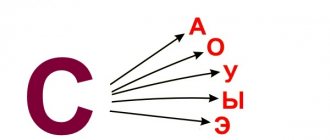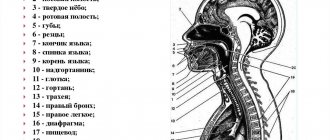The emergence of speech in humans and the formation of sounds is possible thanks to the speech apparatus. The speech apparatus is a set of coordinated organs that help form the voice, regulate it and form it into meaningful expressions. Thus, the human speech apparatus includes all elements directly involved in the creation of sounds - the articulatory apparatus, including the central nervous system, respiratory organs - lungs and bronchi, throat and larynx, oral and nasal cavities.
The structure of the speech apparatus
The structure of the human speech apparatus, that is, its structure, is divided into two sections - the central and peripheral sections. The central link is the human brain with its synapses and nerves. The central speech apparatus also includes the higher parts of the central nervous system. The peripheral department, also known as the executive department, is a whole community of elements of the body that ensure the formation of voice and speech. Further, according to the structure, the peripheral part of the speech apparatus is divided into three subsections:
- The department that regulates respiratory processes. Breathing is an important function of the body. It is implemented by special nerve centers and occurs automatically. Sounds from the body always come out during exhalation, and the air wave formed at this moment helps to perform two tasks at once - articulatory function and voice formation. This section includes the lungs and bronchi, the muscles located between the ribs, and the diaphragm.
- Voice department. The voice has three characteristics. This is its power, timbre and height. The work of the vocal cords causes vibrations in the air, transmitted to the outside world, perceived as voice.
- The articulatory apparatus is the department that directly forms sounds into speech. Consists of active and passive organs. Active organs of articulation are movable, helping to form sounds. The main organs of articulation are the lips and tongue, palate and jaw. Their changes in position lead to the creation of narrowings in different places of the articulation department. The character of the sound produced depends on this position. The mandible helps create stressed vowels. The tongue is the main muscle of the articulatory apparatus. The clarity of pronounced sounds depends on its ability to be flexible and transformative. The lips are also a moving part and contribute to the formation of vowel sounds and speech, they are an important organ in the articulation of words, which is helped by the specific placement of the tongue.
Passive organs included in the articulatory apparatus are immobile organs. Their main task is to be the foundation, the basis for active organs. Passive organs include teeth and the entire oral cavity, and the hard palate. As well as the pharynx and larynx. Although they are motionless, they still influence, albeit slightly, the speech potential and character of a person’s speech.
Features of the executive department
It includes three major structural divisions. The first is the respiratory section. Its activity, which is a sequence of inputs, exhalations and pauses between them, is regulated by the central nervous system. The main working “tool” is the diaphragm, which expands and contracts, due to which the lungs change volume and produce inhalations and exhalations. In this case, an air stream is formed, which is important for the formation of the voice; the clarity of the pronunciation of speech sounds depends on its intensity. In addition, the respiratory department includes:
- rib cage;
- lungs;
- intercostal muscles.
The functions of the air stream are voice-forming and articulatory. The sound is formed when you exhale, and the inhalation when speaking becomes deeper and shorter. The number of respiratory movements performed during speech is much greater than directly during physiological breathing. The volume of air inhaled and exhaled during conversations is three times greater than during normal inhalations and exhalations.
Voice education
In the structure and functioning of the speech apparatus, the vocal section plays the most important role; it is responsible for the formation of the voice and its characteristics - timbre, strength, pitch. It includes the larynx and vocal cords, which, vibrating under the influence of an air stream, produce sounds.
The larynx is a tube consisting of soft tissues and cartilage; in its upper part it passes into the pharynx, in the lower part into the trachea. In the place where the larynx connects to the pharynx, the epiglottis is located, which serves as a kind of valve when swallowing: by descending, it prevents pieces of food and saliva from entering it. Organ Features:
- The larynx in men is larger, the vocal cords are longer (up to 2-2.4 cm). In women, the length of the ligaments is 1.8-2 cm.
- The size of the organ in children before puberty is the same, regardless of gender.
- The larynx grows unevenly throughout a person's life. There are periods of active growth in size: 5-7 years, 12-13 (girls) and 13-15 (boys). The latter develop an Adam's apple.
- Changes shape: in children it is in the form of a funnel, in adults it is cylindrical.
The power of the air environment determines the strength of the sound, and the pitch and timbre of the voice depend on the size of the ligaments, their elasticity and degree of tension.
In addition, resonators, which include the pharynx, oral and nasal cavities, also influence the specificity. They change their volume, that is, they resonate, due to which the sounds acquire strength and overtone coloring.
Making sounds
The articulatory department, which includes the tongue and lips, jaws, alveoli, and palate (hard and soft), is responsible for this important process. In science there is a classification of them into active (moving) and passive (stationary). The first group includes the tongue, lips, soft palate and lower jaw; all others belong to the passive category. The profile of the articulatory apparatus will help you visualize what they look like.
The most important organ of the speech apparatus is the tongue, which takes part in the formation of almost all speech sounds with the exception of labial ones. During articulation, the organs move closer to each other, and closures or slits are formed, which causes the formation of a voice.
The extension tube contains resonators, which are responsible for the clarity and volume of speech. This tube has a specific structure that allows it to change shape and volume. It has two main functions - a noise vibrator and a resonator. The first can be performed by the vocal cords, the gaps between the lips, as well as between the tongue and the hard palate, the tongue and lips, the tongue and alveoli, lips and teeth. Features of the formation of various sounds:
- The noise vibrator is involved in the formation of voiceless consonants.
- The tone vibrator allows you to pronounce sonorant and voiced phonemes.
- The nasal cavity takes part in the formation of m, n and their soft variants.
These are the basic structural components of speech and language.
Voice formation
In every language on our planet there is a specific number of sounds that create the acoustic image of the language. The sound finds meaning only in the scheme of sentences and helps to distinguish one letters from others. This sound is called a phoneme of the language. All sounds of a language differ in articulatory characteristics, that is, their difference comes from the formation of sounds in the human speech apparatus. And by acoustic characteristics - by differences in sound.
The voice can be considered the result of the hard work of the muscles of various components of the peripheral speech apparatus. Three of its departments contribute to the formation of sound:
- respiratory, otherwise energetic - includes the lungs, bronchi, trachea and throat;
- voice-forming department, otherwise generator - the larynx along with sound cords and muscles;
- sound-producing, otherwise resonator - the cavity of the oropharynx and nose.
The work of these departments of the speech apparatus in complete symbiosis can only occur through the central control of speech and voice-forming processes. This suggests that the respiratory process, articulatory mechanism and sound formation are completely controlled by the human nervous system. Its impact also extends to peripheral processes:
- the functioning of the respiratory organs regulates the power of the voice;
- the functioning of the oral cavity is responsible for the formation of vowels and consonants and for the difference in the articulatory process during their formation;
- The nose section provides adjustment of the overtones of the sound.
The central speech apparatus occupies a key place in the formation of the voice. The human jaw and lips, palate and supraglottic lobe, pharynx and lungs are all involved in the process. The air flow leaving the body, going further through the larynx and passing through the mouth and nose is the source of sound. On its way, the air passes through the vocal cords. If they are relaxed, then the sound is not formed and passes freely. If they are close and tense, the air creates vibration as it passes. The result of this process is sound. And then, with the work of the movable organs of the oral cavity, the direct formation of letters and words occurs.
Possible problems
The structure of the voice apparatus, as well as the functional features of each of its departments, will help you work out what problems may arise. In speech therapy, it is customary to distinguish several types of disorders:
- Incorrect use of speech organs.
- Violation of the structure of organs or tissues.
- Problems with the parts of the nervous system whose function is to ensure the pronunciation of phonemes.
In addition, children may experience delayed speech development (SDD), the essence of which is the inability to pronounce certain sounds, the inability to express emotions, and lack of control over intonation. Also included in the developmental developmental disorder are underdeveloped vocabulary, the absence of phrasal speech in 2-year-olds, and the absence of coherent speech in 3-year-olds. These defects should be eliminated as soon as possible by contacting speech therapists, otherwise they may cause the child to be unable to learn to write and read normally.
The vocal apparatus is the most important part of the human body; it helps people communicate with each other and find their place in society. For this reason, any problem detected in early childhood must be addressed immediately.
Structural components of speech
Responsible for speech function:
- The sensory speech center is the perception of speech sounds, based on the sound discrimination system of the language; Wernicke's area in the left hemisphere of the brain is responsible for this process.
- The center of motor speech - Broca's area is responsible for it, thanks to it it is possible to reproduce sounds, words and phrases.
In this regard, in clinical psychology there is the concept of impressive speech, in other words, the understanding and presentation of oral and written speech. There is also the concept of expressive speech - that which is spoken out loud accompanied by a certain tempo, rhythm, and emotions.
In the process of speech formation, each person should have a clear understanding of the following subsystems of their native language:
- phonetics (what syllables, sound combinations can be, their correct structure and combination);
- syntax (understanding exactly how the relationships and combinations between words occur);
- vocabulary (knowledge of the vocabulary of the language)
- semantics (the ability to understand the meaning of words long before acquiring pronunciation skills);
- pragmatics (relationships between sign systems and those who use them).
The phonological component of a language means knowledge of the semantic units of the language (phonemes). Physically, speech sounds can be divided into noises (consonants) and tones (vowels). Any language is based on a certain distinctive feature; if you change one of them, the meaning of the word will change dramatically. The main semantic distinguishing features include deafness and sonority, softness and hardness, as well as stress and unstress. It is these features that act as the basis of the phonemes of the language system. Each language has a different number of semantic units, usually from 11 to 141.
The Russian language involves the use of 42 phonemes, in particular, 6 vowels and 36 consonants.
It has been scientifically proven that any healthy infant in the first year of life has the ability to reproduce 75 different shortest sound units, in other words, can learn any language. But, most often, children at the initial stages of their development are in only one language environment, so over time they lose the ability to reproduce sounds that do not belong to their native Russian language.
Classification of vowel sounds.
The basis for the classification of vowels is the row and rise of the tongue, as well as the work of the lips. Articulatory vowels are distributed horizontally along the row, that is, along the part of the tongue that is raised when pronouncing a given sound. There are three rows, and accordingly three types of speech sounds, which are front, middle and back. Front vowels - and e; middle row - s; back row at o a. Vertically, vowels differ in their rise - that is, in the degree of elevation of one or another part of the tongue during the formation of a given vowel. There are usually three lifts - upper, middle and lower. In the Russian language, high vowels include u y, middle vowels e o, and low vowels a.
According to the position of the lips, vowels are divided into labial, that is, in the formation of which the lips take part - o u (labialized, rounded) and unglobbed, that is, in the formation of which the lips do not take part - a e and y. Labial vowels are usually back. Nasalization. In a number of languages, there are nasal vowels, for example, in French and Polish. Old Church Slavonic also featured nasal vowels, which in Cyrillic were represented by special letters: yus large, or o nasal and yus small, or e nasal. Articulation of nasal vowels occurs when raised? the palatine curtain and the lowered back of the tongue, so that the air stream simultaneously and equally enters the oral and nasal cavity.



